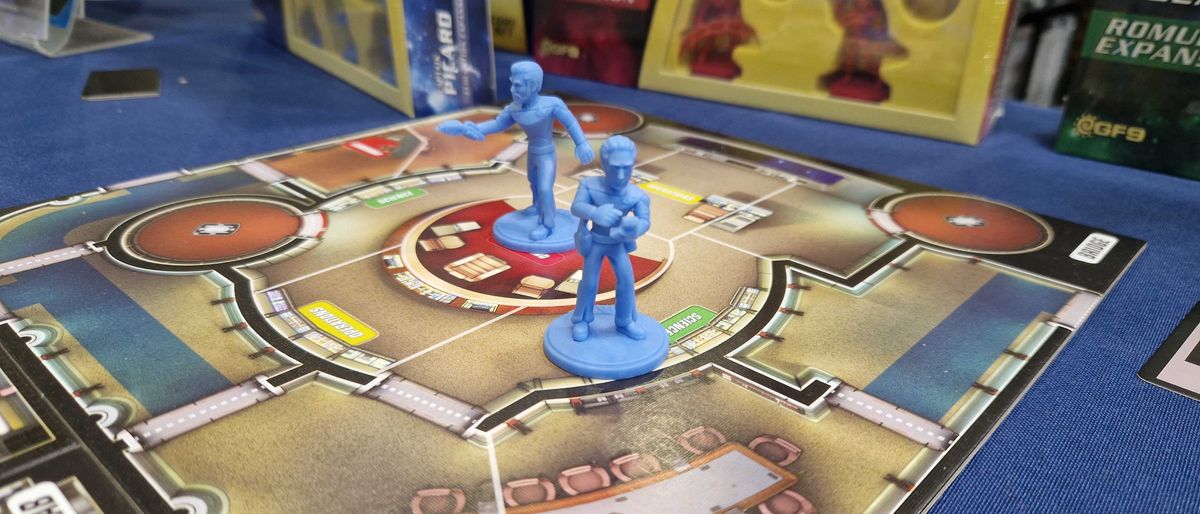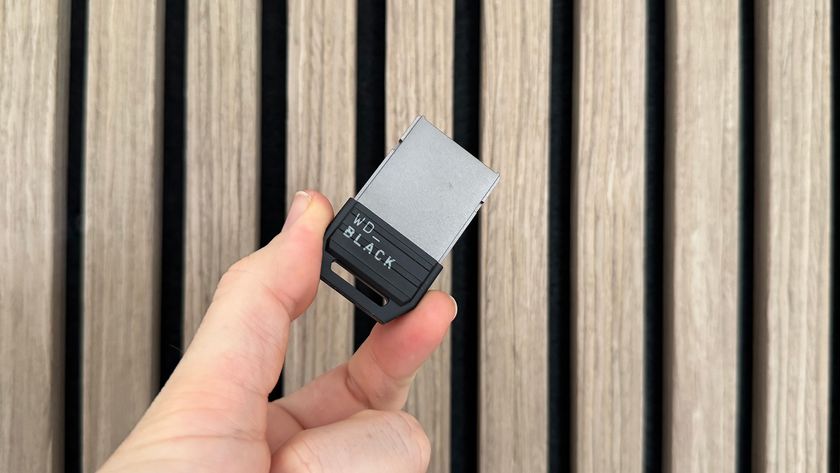12DOVE Verdict
It's amazing that we've waited so long for a wargame set in this universe, and the Star Trek: Away Missions starter set shows how much promise that idea has. A fast-paced but tactical system powers everything, and deck-building mechanics help it achieve warp factor nine. However, the core box isn't perfect. The factions inside feel very unbalanced, and its missions encourage players to ignore each other and rush to complete menial tasks instead. Indeed, Away Missions doesn't shine until you throw in the expansion packs.
Pros
- +
Great core system with lots of fast-paced tactical decision-making
- +
Different board layouts and deck building offers plenty of variety
- +
Fun, if controversial, chibi-style Star Trek miniatures
Cons
- -
Keywords and card effects make it more complex than it appears
- -
Default objective decks lead to weirdly insular, non-interactive gameplay
- -
Teams in core set are very poorly balanced
Why you can trust 12DOVE
Star Trek: Away Missions feels like a no-brainer at first glance, and it's surprising we don't have a wargame like it already. Given its widespread popularity, Star Trek is an under-served franchise in the board gaming world; it has fewer games than many other well-known sci-fi settings, and those it does have tend to be lower quality. Witness the wild success of Star Wars: X-Wing compared to its cousin Star Trek: Attack Wing, for example.
One of the many gaps that games have yet to boldly go is skirmish combat in the setting. But Star Trek: Away Missions aims to solve all these problems with its new core box offering. Does it manage to take its rightful place amongst the best board games?
Star Trek: Away Missions features & design
| Price | $60 / £55 |
| Ages | 14+ |
| Players | 2 |
| Complexity | Medium |
| Genre | Wargame |
| Lasts | 60 - 90mins |
| Publisher | Gale Force Nine |
| Play if you like | Underworlds, Godtear, Kill Team |
- Small-scale wargame using board tiles
- Each player has a unique team and deck
- Contests resolved by rolling dice pools and comparing results
In Star Trek: Away Missions, you take command of a small strike team striving to "complete missions, conduct espionage, fight in glorious battle, or assimilate distinctiveness" across three rounds.
This core box comes with two teams. First are some famous faces from the Next Generation era of the USS Enterprise: Riker, Data, Worf, and Shelby. Against them are the faceless, identikit Borg, except for their leader, Locutus, a mechanised version of Captain Picard.

Away Missions is played over three rounds, and players take turns activating figures. They get two actions each: moving, attacking, and taking cover. Many cards (like Support buffs and Mission cards that earn you points) also require an action to play. Eventually, though, it all comes down to skill checks. These involve rolling a pool of dice based on the character’s skill rating, with bonuses for specialities. In combat, you must get a better attack score than your target's defence roll. (In a fun twist, the Borg can actually assimilate characters that they kill, adding them to their side as drones.)
That's because it recreates the Battle of Wolf 359, part of a particularly tense Next Gen arc and one of the more dramatic conflicts in Star Fleet's history. In other words, it's a great backdrop for a wargame.
However, these are not the only teams you can use to play the game. Romulan and Klingon away teams are also available as expansions. All the figures are sculpted well but in an odd, stylised cartoon fashion with big heads and slender limbs that some may find off-putting.
You can play Star Trek: Away Missions quite easily out of the box with the included quick-start guide. This gives you an initial board layout and instructs you to use the pre-made card decks for each side. As you gain confidence with the game, building the board from the supplied pieces and choosing what cards you want in your starting decks becomes part of the strategy and tactics of the game. There are also additional cards for both factions supplied for you to tinker into your decks, not unlike Warhammer Underworlds: Deathgorge.
Star Trek: Away Missions gameplay
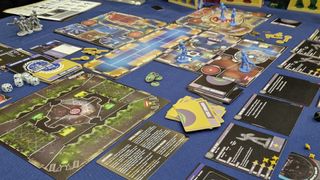
- The core play mechanics are smooth, varied, and exciting
- Starter decks make for a dull game and are not well-balanced at all
- When the game works well, it really brings the Star Trek universe to life
If you’ve ever played Games Workshop’s Warhammer Underworlds series, then you probably got a feeling of déjà vu from reading the rules outline above. Star Trek: Away Missions is very clearly inspired by that already excellent game engine, and the changes are mostly for the better. Bonus action tokens make it more balanced to field teams of different sizes. The jigsaw board and varied stations and computer terminals offer more variety to work with, too. Plus, pairing off standard dice is faster and easier than the custom dice used in Underworlds.
Given the effort that must’ve gone into refining and improving the core game concepts, it is, therefore, rather surprising that the design makes such a mess in terms of game balance and mission cards.
It’s the latter you’ll notice first. On your initial play, with two freshly-drawn hands of cards to juggle, you’ll take a while to read all the text and line up the relevant game concepts in your head. The complexity added by the text-dense cards, often focusing on keywords or board elements, is a significant step-up over the simple-seeming game concepts in the rulebook. Still, once internalised, you’ll set to. The Federation’s highest scoring mission cards are based on repairing systems, which involves one or more characters passing skill checks at terminals. The Borg, meanwhile, get most points from assimilating parts of the ship, which also requires skill checks that build up successes over multiple rounds.

Alongside this core starter set, you can pick up new warbands via expansion packs. There's Chancellor Gowron's Klingon Honor Guard, Sela's Romulan Infiltrators, the Klingon House of Duras, and Captain's Picard's Federation officers (these are characters missed in the beginner box, like Jordi and Dr. Crusher).
So your initial focus is going to be on getting places and passing skill checks, which you’ll rush to do, almost completely ignoring your opponent. You might be tempted to stop and take a pot-shot, but with only three rounds and a lot of ground to cover, if you want to bag maximum points, you’ll quickly realise this is largely a waste of actions. The issue is exacerbated by the fact you draw up to a full hand of missions each turn, so the more you can cross off, the more you get back. There are a few combat-centric missions in each deck, but they award paltry points compared to the more sedate challenges. Plus, the starter setup actively encourages you to select overarching objectives for bonus points that avoid combat, even though more interactive options are available.
Whichever objective you choose, as soon as you start bagging points you’ll notice another discrepancy. The Federation’s missions are both higher-scoring and easier to achieve than those of the Borg. As a result, it’s much easier to win.
This imbalance is so obvious that it’s presumably a built-in calculation to stop the Borg assimilating too many enemy characters and running away with the game. Which would make sense, were the Borg better in combat. But individually the drones are very weak, so they have to team up to take down the opposition, and that’s more actions spent fighting and not scoring missions. There’s probably a play style that makes them work, but it’s very far from obvious out of the box, and players will likely grow frustrated before figuring it out.
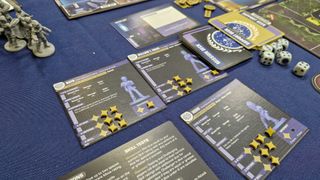
And that’s a shame, because when Star Trek: Away Missions works, it works beautifully. The interplay between cards, keywords, and board elements fills the game with variety and narrative. The tight round count makes it feel like every choice, every action, every dice roll is pivotal towards the overall outcome, with the game flip-flopping the advantage towards a thrilling finish. Similarly, the ability to build your own decks has promise. The mix provided for the Federation isn’t terribly interesting (it's still skill-test heavy), but the Borg can definitely be customised in a couple of different ways... one of which is more aggressive, while the other involves Locutus’ special ability of pulling out support cards with a particular keyword.
It’s just that you won’t get to see a lot of this smooth running using the factions in the core set alone. If you have access to the better-balanced and more varied Romulan and Klingon expansions, then you can get a better sight of what the game can be.
Should you buy Star Trek: Away Missions?
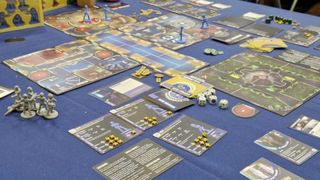
If you like the franchise, and you’re drawn to Star Trek: Away Missions despite the flaws in the core box, then there is a solution – go all in. Pick up the expansions and you’ll find that this feels like a very different game. With more aggressive objectives and combat-oriented cards, they add the life and balance that the core set is missing, as well as extending the replay value with their additional cards and deck-building. But this core set alone is hard to recommend on its own merits. You’d be better off sticking with a Warhammer Underworlds starter set instead.
Buy it if...
✅ You’re a fan of Star Trek and love the idea of playing with your favorite characters
Because this wargame uses the Next Generation cast, you can bring Star Trek royalty - along with some of their greatest villains - to your tabletop.
✅ You’re happy to go all-in and buy expansions alongside the starter set
It's only when the expansion sets are added that Away Missions finds its feet, so the game is at its best when you branch out from the core set.
Don't buy it if...
❌ You’re not willing to explore the deck and board-building options of the game
Seeing as Star Trek: Away Missions only comes to life with its deck and board building options, avoiding them won't leave the best impression.
❌ You prefer carefully balanced games with little randomness
It's less of an issue when you add expansions into the mix, but the starter set isn't the best for balance.
How we tested Star Trek: Away Missions
Disclaimer
This review sample was provided by the publisher.
As with all of our reviews on 12DOVE, our reviewer played this board game multiple times to get a full and well-rounded sense of how it worked, its longevity, and how accessible it was.
You can learn more about our process via the following review policy. Alternatively, you can check out the following guide on how we test board games.
More info
| Genre | Wargame |
Matt is a freelance writer specialising in board games and tabletop. With over a decade of reviews under his belt, he has racked up credits including IGN, Dicebreaker, T3, and The Guardian.
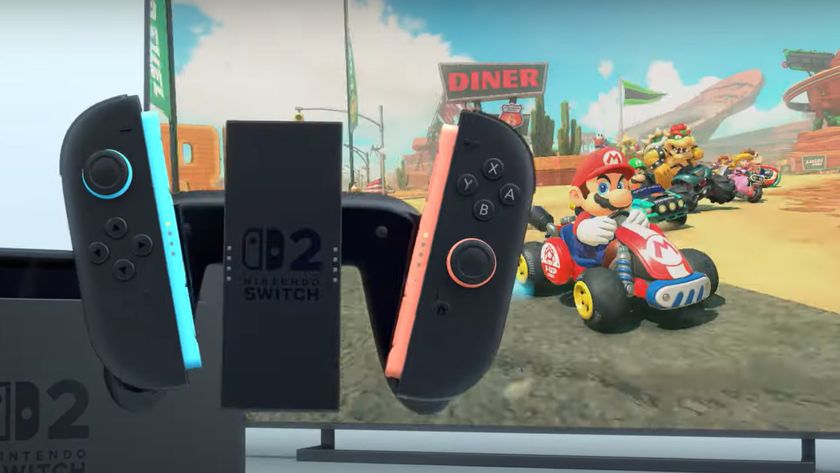
Ex Nintendo PR managers say the Switch 2 generation is likely to see the retirement of "several of the major developers at Nintendo who we have known for 40 something years"

Helldivers 2 CEO says industry layoffs have seen "very little accountability" from executives who "let go of one third of the company because you made stupid decisions"

Spider-Man: Brand New Day - How Peter Parker and Mary Jane's break up led to one of the wall-crawler's most transformative comic eras
